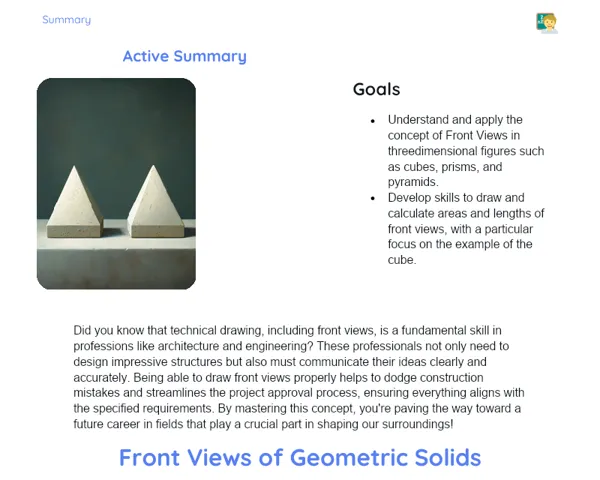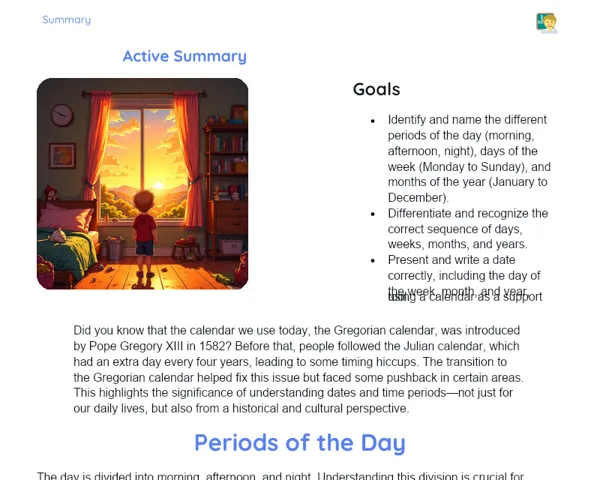Socioemotional Summary Conclusion
Goals
1. Identify right and non-right angles in flat shapes.
2. Count how many right and non-right angles are in basic geometric figures, such as squares and triangles.
Contextualization
Did you know that angles are all around us? From the corners of our couches to the intersections of the streets we walk every day! Being able to spot these angles helps us do things more efficiently, like putting together furniture or even charting a route. Let's dive into the exciting realm of right and non-right angles and see how they are part of our everyday lives!
Exercising Your Knowledge
What are Angles?
Angles are created when two rays meet at a common point, known as the vertex. Knowing this is key to grasping the basics of geometry, which we encounter daily, from the tools we use to the buildings we see around us.
-
The two sides of an angle are referred to as rays.
-
The point where the rays meet is called the vertex.
-
Angles can be measured in degrees or radians.
Right Angles
A right angle measures exactly 90 degrees. You'll find them in a range of geometric shapes and everyday items, like squares, rectangles, and even the corners of our streets.
-
A right angle is precisely 90 degrees.
-
It's shown as a small square at the vertex in diagrams.
-
You can easily spot it using a carpenter's square.
Non-Right Angles
Non-right angles are those that aren't 90 degrees. These can be classified as acute (less than 90 degrees) or obtuse (more than 90 degrees). They're found in many geometric figures and both natural and man-made objects.
-
Acute angles measure less than 90 degrees.
-
Obtuse angles measure more than 90 degrees.
-
They're common in various non-right triangles and many everyday items.
Spotting Angles
To determine if an angle is right or non-right, you can use tools like a carpenter's square or compare it to a known 90-degree angle. This ability to identify angles is crucial for tackling geometric problems and grasping spatial awareness.
-
Use a carpenter's square for identifying right angles.
-
Check against a known right angle to see if others are non-right.
-
Accurately identifying angles is helpful for practical tasks and solving math problems.
Key Terms
-
Angle
-
Vertex
-
Ray
-
Right Angle
-
Acute Angle
-
Obtuse Angle
-
Carpenter's Square
For Reflection
-
How can understanding angles benefit you in activities outside of school? Can you think of some real-life examples?
-
What feelings came up when learning about right and non-right angles? How did you navigate those emotions during the lesson?
-
Did collaborating with others enhance your understanding of the content? In what ways did teamwork impact your learning and feelings?
Important Conclusions
-
Angles are part of our daily life, and knowing the difference between right and non-right angles is vital for various practical tasks.
-
Right angles are those measuring exactly 90 degrees and can be found in squares and rectangles, while non-right angles can be acute (less than 90 degrees) or obtuse (more than 90 degrees).
-
Being able to identify and count angles in shapes not only sharpens your math skills but also enhances your observation and critical thinking skills.
Impacts on Society
Angles play an important role in many aspects of our lives. For instance, in engineering and architecture, having precise angles is key to ensuring buildings are stable and visually appealing. Plus, in everyday tasks like assembling furniture or sketching maps, knowing how to work with angles makes things simpler, efficient, and accurate.
On an emotional note, grasping angles can be quite fulfilling. Picture the satisfaction you feel when you correctly identify all the angles in a challenging figure, or when you finish crafting something that fits flawlessly! These small achievements can boost your self-confidence and motivation to take on new challenges, both in school and beyond.
Dealing with Emotions
To keep your emotions in check while learning about angles, try using the RULER method. Start by recognising how you feel when you tackle this topic. Then, uncover what's triggering those emotions—maybe it's the struggle to grasp certain concepts or the thrill of solving a problem. Label these feelings, like 'frustration' or 'joy'. Share your feelings appropriately, either with friends or your teachers. Lastly, manage your emotions by finding ways to stay calm and focused, like taking short breaks and practising deep breathing.
Study Tips
-
Practice sketching different geometric shapes and identifying right and non-right angles.
-
Use items around your home, like furniture and books, to spot and count the angles present.
-
Form small study groups with friends to chat about and compare your discoveries related to angles in various figures and objects. This encourages collaborative learning.



